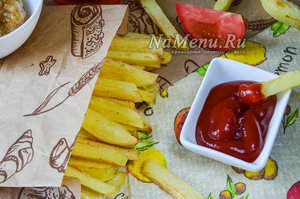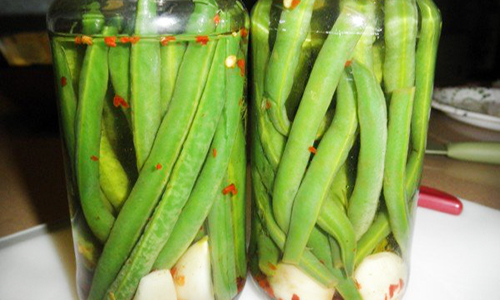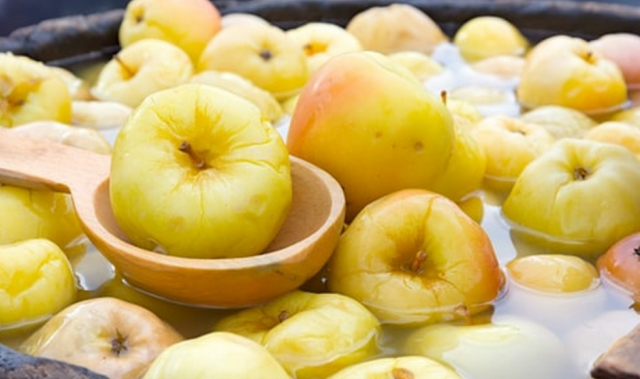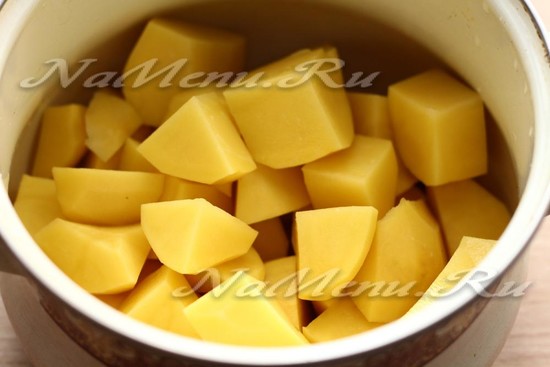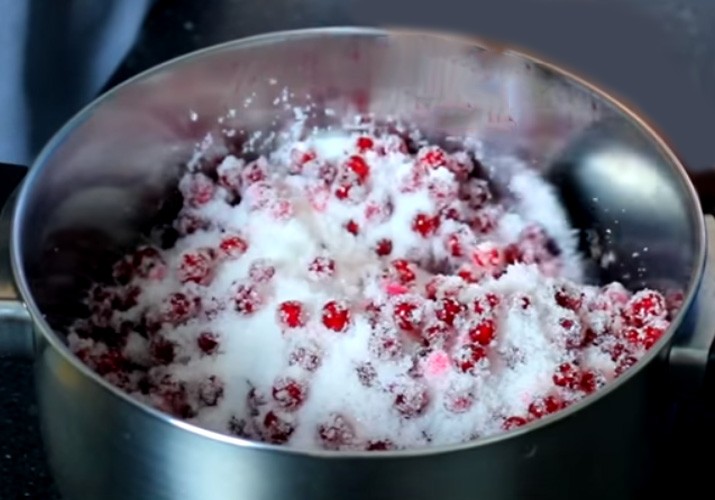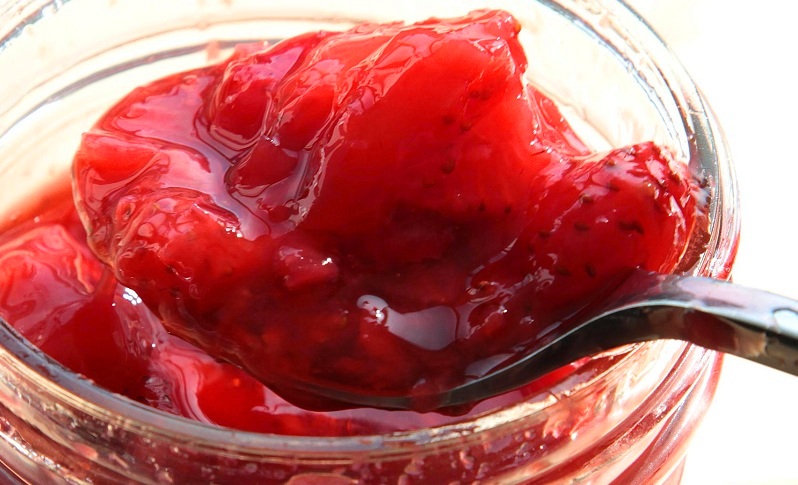Appetizing recipes for winter bean preparations: how to preserve red bean salads for the winter. Preservation of beans for the winter at home
With the onset of cold weather, winter salads are very popular among homemade dishes. Salad with beans for the winter turns out to be especially tasty if all the ingredients were grown on a personal plot. This is a cold appetizer, which in addition to beans includes all the usual ingredients for us: red bell pepper, onion, fresh tomatoes. The addition of carrots will not be superfluous. It is worth noting that this kind of lecho with beans is perfect for menus during Lent. When meat is strictly prohibited, red beans will be an alternative to animal protein. For every vegetarian, this product is considered an energy source.
Winter Bean Salad
Recipe without sterilization. Subject to the indicated proportions, you can prepare as many as four liters of a delicious salad of vegetables with beans.
We pre-harvest: half a kilogram of ordinary white onion, a couple of kilograms of tomatoes, 50 grams of salt, a kilogram of beans, vegetable oil (400 ml), half a kilogram of red bell pepper. In addition, the composition includes 1 tablespoon of sugar, garlic (100 grams) and five teaspoons of 70% vinegar.
How to cook beans for the winter without sterilization
Before you start cooking, it is recommended to thoroughly rinse the beans and soak it overnight. Cook for half an hour and send in a colander to get rid of excess fluid. It is worth noting that beans are of different varieties, so the cooking time may vary. If after half an hour the beans remain solid, extend the time.
We take out the stalk and clean the bell peppers from the seeds and. Depending on your preference, we cut into a convenient way, you can cubes or straws, the main thing is that the pieces are not very large.
We chop the onion with straws. White onions can be replaced with purple. As a rule, the taste does not suffer from such a replacement.
You need to chop the tomatoes with a blender or a manual meat grinder. If there is no special equipment at home, then you can use an ordinary grater. Most housewives pre-dip the tomatoes for five minutes in boiling water, so that it is easier to rid them of the peel.
We take a medium-sized pot, and send the prepared vegetables along with the resulting tomato puree. Pour in the sunflower oil and mix. Cook over high heat until it boils, and then continue to simmer for twenty minutes. Next, add the beans. Finely chop the garlic, or pass through a special press. Add sugar, vinegar, salt and garlic to the pan to boiling vegetables. Continue to simmer for fifteen minutes.
It is most convenient to store beans for the winter in small banks, as they say, at one time. It is previously recommended to sterilize containers. It is necessary to shift the finished snack in dry cans. We roll up using clean and sterile covers, knock over and wrap in a blanket. In order for the appetizer to maintain its quality, it is recommended to store it in a cool and dark place.
Recipe number 2
Do you often buy canned beans in banks at the store? We offer to cook homemade haricot beans for the winter yourself.
The recipe is good in that you can use it as an independent dish in the form of a salad of beans with vegetables, and use the workpiece as a seasoning or sauce for the second dishes. And also winter stocks of beans in tomato sauce are the most delicious and simple dressing for winter cabbage soup or borsch.
Beans for the winter in tomato sauce

When you get a jar of beans from the pantry - it will be enough for you to throw cabbage and potatoes into the broth, add a few tablespoons of borsch seasoning and cook a little. A delicious hearty soup or fragrant borsch, regardless of the time of year, you can always cook in a hurry!
Thus, you will not only save money and time, but will also delight your family with their favorite dish with the addition of beans.
Beans for the winter in the banks can cook every housewife. For the preparation of 3.5 liters of billet you will need
People are accustomed from all the gifts of the garden to harvest for the future only berries, vegetables and fruits. But what about the rest of the plant crops: legumes, grains, and others? After all, they can not only be stored after preliminary drying. Many do not even suspect how to preserve beans at home, so that it turns into a useful semi-finished product or a full-fledged dish.
Simplest option
In its homeland, in Latin America, beans are the most popular product. It is used in a variety of forms almost every day. For us, it is just a side dish, an addition to the main dish. And so that any housewife could always have such an additive on hand, you need to know how to preserve beans at home. In stores, such a product is not cheap. Therefore, it is better to master a few simple recipes on your own. The first option is pickling. To begin to understand how to preserve beans at home, you need to prepare the necessary products for this. For every kilogram you need a little more than 3 liters of water, 120 grams of sugar and salt, 3 teaspoons of vinegar essence and spices (peas, cloves, bay leaf, coriander and mustard seeds), which are best suited for this.
The secret to preserving beans at home is pretty simple:
- First you need to wet the product. If the beans are fresh, then one hour will be enough. If they are dried, it will take a whole night.
- After this, the liquid needs to be drained, and the beans along with the other components are collected in one pan, put it on the fire and bring the contents to a boil.
- Then the fire can be made a little smaller and continue cooking for at least an hour and a half.
- Add vinegar three minutes before graduation.
Now the hot product can be packed up, rolled up, and after cooling down safely send to storage.

Any product has completely different types and varieties. Their processing and use in cooking can vary. Therefore, you must additionally know how to preserve asparagus beans at home. Some confuse it with asparagus, in which young shoots go for food. Here we are talking about green pods, which are very beneficial for the body. There are several ways to preserve them. For one of them you will need: 0.5 kilograms of beans, 50 grams of vinegar, fresh dill and parsley, 10 peas of pepper, one and a half grams of horseradish and ground cinnamon, 3 cloves, a tablespoon of sugar and twice as much salt.
Now you need to remember the sequence of how to preserve asparagus beans at home:
- Cut the washed pods into 3 parts.
- Lightly fry them in any vegetable oil.
- Cook the marinade. To do this, dissolve sugar and salt in a liter of water and boil. After 10 minutes add vinegar.
- Beans put in banks.
- Add herbs and spices, and then pour the marinade.
- Hold the jars for 15 minutes in a water bath under the lid and only then roll them up.
Appetizing mixes

Cooking knows many options for how to preserve. At home, you can take the initiative and add, for example, some vegetables. You will need the following ingredients: 3 kilograms of tomatoes, 2 and a half kilograms of beans and bell pepper, 100 grams of salt and vinegar, 3 heads of garlic, as well as a glass of sugar and olive oil.
The process takes place in the usual sequence:
- Dip the tomatoes in boiling water, and then, peeling them off, grind in a meat grinder.
- In the resulting thick juice add salt, vinegar, sugar, butter and grated garlic.
- Boil the mixture and cook for 20 minutes.
- Beans with pulp of Bulgarian pepper cut into slices and dip in a tomato composition.
- After half an hour, the resulting product is laid out in jars and corked.
Such canned goods will be a real find. They can be used daily as a side dish or served on the festive table as a separate dish. In addition, it will be an excellent component for a fresh salad, stew or vegetable soup.
Popular method

The previous options have one, but a significant drawback. This is vinegar. He is an excellent preservative, but gives the product a special acidity that not everyone likes. But there are other ways in which this component is missing. For example, you can consider how to preserve red beans at home. In this case, the list of ingredients will be minimal: for 2 kilograms of fresh beans, you will need only water and 3 tablespoons of salt.
Cooking method:
- Fresh fruits must first be filled with water and left in this condition all night.
- Then they need to be washed well from the formed mucus, placed in a pot with cold water and cook for 2 hours at a moderate boil.
- Once the amount of water is halved, add salt.
- Place the hot product with the liquid in prepared sterile containers, cover with lids, and then warm for another 20 minutes in a water bath.
- Roll up banks and send them to storage after cooling.
To preserve any bean, you will need glass jars with screw caps and a home canning autoclave. If you have this necessary equipment, then you can preserve both fresh and dry beans. Products containing little acid, including beans, are unsafe to sterilize in a water bath, so if you usually use this method of preservation, you will need to purchase a home autoclave and do everything according to the instructions below.
Steps
Part 1
Preparation of dry beans for canningRemove damaged beans and small pebbles. Remove all small pebbles and shriveled or damaged bean beans. Damaged beans will only interfere with the preservation process, so it is best to remove them.
Rinse the beans. Rinse the beans with room temperature water and place in a large pot.
Soak the beans. After you have washed the beans, pour the water into the pan (take at least two volumes of water per volume of beans) and soak the beans by choosing one of the two methods below:
Drain the water. The water in which you soaked the beans became dirty, and some complex polysaccharides that cause gas formation also passed into it. Drain and pour clean water before putting the beans on the fire.
Boil the beans. Pour the beans with clean water, bring to a boil and cook for 30 minutes. You can add seasonings to the pan or boil only beans, in this case your canned goods will have a neutral taste.
Draw a knife along the walls of each jar. So you can remove from the can all air bubbles that can impair the color and taste of canned beans.
Wipe the covers. Take a piece of clean cloth and wipe the edges of each jar. You don’t want any pollution to get into your canned food.
Close the jars with lids. Using kitchen tongs or a magnet, remove the lids from the pot of boiling water and close the jars with them. Put on the kitchen gloves and close each lid.
Part 3
Bean Preservation- Large autoclaves can be sold with two grates, a second grate can be placed on top of the first level of cans and placed on top of the second level of cans.
-
Attach the lid of the autoclave. In some autoclave models, it is sufficient to place the lid on top and turn the locking mechanism to close the lid. In other models, you will have to tighten special bolts to attach the cover to the autoclave body.
Heat the autoclave until steam appears. Turn on the heat and heat the autoclave until steam escapes from under the lid.
Let the couple go out for 10 minutes. During this time, the conditions of high temperature and pressure necessary for preserving are formed inside the autoclave.
-
Set the time and pressure needed to sterilize your bean cans. These options vary depending on the autoclave model, the height of your place of residence above sea level and the variety of beans. It is best to follow the instructions that came with your autoclave. Here we give only approximate parameters if you do not have any other sources of necessary information:
- Sterilize the jars at a pressure of 0.7-0.09 MPa.
- Raise the pressure to at least 1.1 MPa if you live above 300 m above sea level.
- Lima beans should be autoclaved for 40 minutes, and previously soaked dry beans - 75 minutes.
- If you have very large beans, leave it in the autoclave for another 10 minutes.
- Increase the canning time by another 10 minutes if you took cans of 1 liter instead of 0.5 liters.
Preserve beans in a home autoclave; do not use a water bath for this. Canning in a water bath dangerous for low-acid foods, including beans, because deadly botulism pathogens can develop in these foods. Be sure to sterilize canned food in an autoclave, because with this treatment all spores of botulism pathogens die.
Place a metal grill in the autoclave. At least one grill is attached to each autoclave. Place it at the bottom of the autoclave so that it rises slightly above the surface.
Place the jars of beans on the wire rack. Use kitchen tongs to place full cans on the wire rack inside the autoclave.
Beans are a rare, but very useful guest on our table. It is eaten boiled, stewed, canned. Being a source of many useful elements, it becomes one of the main products in diet food.
Consider how to prepare beans for the winter in several ways.
About the benefits of beans
A unique set of vitamins and elements indicates the need for presence in our diet.  Beneficial features:
Beneficial features:
- iron in the composition improves the circulatory system;
- an excellent source of protein for severe physical exertion;
- restores metabolism, improves skin, hair and nails;
- magnesium increases stress resistance and improves sleep;
- satisfies hunger well.
Preparation of cans and lids
Everything that will be used in canning should be thoroughly washed. If used cans are used, they must be washed especially carefully.
Today in culinary uses such:
- For a couple. A grate is installed in a pot of boiling water. A can is placed on the wire rack, which is processed from 10 to 20 minutes, depending on the volume.
- In the oven. Heat the oven to 160 ° C. Put cans in it. Stand for 10 minutes. It is not necessary to take out the dishes immediately to avoid sudden contact of hot glass with cold air.
- In the microwave. Pour some water into the pan. Set the microwave to maximum temperature and load the cans. Processing time - 10 minutes.
Did you know? The unique ability of soda to neutralize the activity of microorganisms is widely used in the food industry. It is this property that makes soda indispensable in preparing cans for sterilization. Soda does not leave a smell and is harmless to the body. When processing jars, use a new sponge: it does not contain germs, odors and food debris.
For preservation, the iron caps are boiled in boiling water for 10 minutes. Lids must be treated immediately before use. 
Salad with vegetables
One of the most common salads for the winter is beans with vegetables. It can be eaten as a separate dish and used as a side dish. Such a salad will provide you with the whole complex of vitamins and elements, which is especially useful in the winter.
Essential Ingredients
- - 1.5 kg;
- beans, sweet pepper - 0.5 kg each;
- 100 g of sugar and 50 g of salt;
- - 1 head;
- sunflower oil - 1 cup;
- 2 tablespoons of 9% vinegar.
 The weight of all vegetables is indicated in purified form.
The weight of all vegetables is indicated in purified form. Recipe
Preparation of vegetables:
Sort beans and remove damaged specimens (shriveled, with traces of bugs, etc.). Pour cold water overnight. If the grains are young, then just put them to swell for several hours.
The remaining vegetables are washed, peeled and peeled, cut. Tomatoes are chopped.
Cooking:

Important! Usually the jar is filled to the neck. This is not entirely correct, since a large amount of air will darken the top layer of the product. Therefore, the optimal volume is filling the cans, not reaching the edge of 1-2 cm.
Video: cooking beans in tomato
Beans in Tomato
A wonderful classic appetizer, as well as an independent vegetable dish. It can be eaten hot and cold.
Essential Ingredients
- 1.5 kg of beans;
- for every 200 grams of raw materials you will need 2 tablespoons of tomato paste;
- 25-50 g of salt;
- table vinegar.
Recipe
Training:
Sort, take out spoiled beans. Rinse well with warm water. Pour in water and leave to swell. For this, fresh beans are enough for 2-3 hours. If the beans are old - leave them in the water overnight.
We rinse with running water.
Cooking:

Video: preservation of beans in tomato
Greek salad with beans for the winter
A feature of this salad is white beans. Its unique properties improve the functioning of the circulatory system. The salad will be very useful for people with low hemoglobin and metabolic disorders.
Essential Ingredients
- 1 kg of beans, onions, sweet peppers, carrots;
- 2.5 kg of tomatoes;
- 1 cup or a little more vegetable oil;
- 2 heads of garlic;
- 1 pod;
- 1 tablespoon of salt;
- 2-3 tablespoons of sugar;
- 1 tablespoon of vinegar to 3 liters of the finished mixture.

Recipe
Training:
Beans are sorted, washed, soaked until swelling. Next, drain the water, rinse and set to boil until half cooked. My vegetables, peeled, chopped. From tomatoes, remove the skin and grind in a blender.
Cooking:

Video: recipe for a Greek salad with vegetables and beans
Important! The growth and development of bacteria causes an excess of sugar or salt. To avoid problems caused by the excessive content of these products, vinegar is used in canning. You just need to add it at the very end. This should prevent the development of microorganisms.
Dressing for borsch for the winter
The winter period does not please us with vegetable diversity. Vegetable preparations for the winter help replenish the reserves of vitamins on our table. A borsch dressing will make this dish tastier and richer, and will also keep for you a wonderful taste of the summer vegetable assortment.
Essential Ingredients
- 1.5 kg of beets and tomatoes;
- 0.5 kg of sweet pepper, carrots, onions;
- 300 g of beans and vegetable oil;
- 80 ml of 9% vinegar;
- 1 tablespoon of salt;
- 3 tablespoons of sugar.
Many in the beds grow asparagus beans, preserving recipes for the winter of which will help turn this useful plant into a wonderful provision. Such a workpiece can be used as a side dish or as a component of salad. Beans belong to the legume family, therefore it is very high in calories. In addition to calorie content, it is tasty and unusual. Having a dish on the table with green beans, you will stock up on energy and useful trace elements for the whole day.
The benefits of asparagus beans and dishes from it
Green beans contains vitamins A, B, C, E, potassium, magnesium, zinc, folic acid, which favorably affect the human body. By intensively cleansing the body of toxins, this herbaceous plant still removes excess fluid from organs, thereby facilitating the work of the heart. Once on the menu for diabetics, it lowers glucose levels, so it is highly recommended that you use them as often as possible. Year-round fails, because asparagus is a seasonal fruit. To save it for a long time, you can freeze or preserve it. Asparagus beans, whose preparations for the winter are countless, can be fed with positive substances from them at any time of the year.
Easily digestible protein inside the bean in question reaches the level of meat. If you are on a diet, then meat can be replaced with asparagus beans in any form. It is also very useful for people suffering from diseases of the kidneys, liver, because it normalizes salt metabolism. Using canned pods can prevent atherosclerosis and arrhythmia.
Asparagus beans cannot be eaten raw.
Winter asparagus without additives for sterilization
 Those interested in how to cook asparagus beans deliciously and without additives, below is a simple recipe. It will go 2 kg of asparagus pods. Beans will be stored in brine, which will take 3 teaspoons of salt and 2 liters of water. Jars are better to pick up 0.5 liter, they will pour 3 teaspoons of vinegar into them for better preservation of provisions.
Those interested in how to cook asparagus beans deliciously and without additives, below is a simple recipe. It will go 2 kg of asparagus pods. Beans will be stored in brine, which will take 3 teaspoons of salt and 2 liters of water. Jars are better to pick up 0.5 liter, they will pour 3 teaspoons of vinegar into them for better preservation of provisions.
Stages of cooking:

In all recipes provided, vinegar is taken 9%.
Winter asparagus with celery without sterilization
 Quickly prepared asparagus beans for the winter, recipes without sterilization which describe in detail the process. This option provides for canning along with celery, which gives piquancy to the dish. The quantity is taken to taste, and the asparagus is 2 kilograms. 100 grams of vinegar, 1 liter of water, 30 grams of salt, 200 grams of sugar will go to the marinade. Garlic and dill will help to add astringency, their volume is taken according to taste preferences.
Quickly prepared asparagus beans for the winter, recipes without sterilization which describe in detail the process. This option provides for canning along with celery, which gives piquancy to the dish. The quantity is taken to taste, and the asparagus is 2 kilograms. 100 grams of vinegar, 1 liter of water, 30 grams of salt, 200 grams of sugar will go to the marinade. Garlic and dill will help to add astringency, their volume is taken according to taste preferences.
Stages of cooking:

Winter beans with spices for the winter without sterilization
 Another delicious recipe for preserving asparagus beans for the winter is its interaction with aromatic spices and spices. 2.5 kilograms of legumes will need up to 10 cloves of garlic, 1 tbsp. tablespoons allspice and black pepper and peas. According to your taste, you can vary the number of ingredients, as well as remove or add some other seasonings, for example, make a bay leaf.
Another delicious recipe for preserving asparagus beans for the winter is its interaction with aromatic spices and spices. 2.5 kilograms of legumes will need up to 10 cloves of garlic, 1 tbsp. tablespoons allspice and black pepper and peas. According to your taste, you can vary the number of ingredients, as well as remove or add some other seasonings, for example, make a bay leaf.
Stages of cooking:

Korean Style Asparagus Beans
 Nutritious, juicy asparagus provisions can be obtained by adding carrots to it. Korean style asparagus beans are a rich appetizer with a speck on any table. The main ingredients for this dish: 500 grams of legumes, 1 large carrot. A bag of spices “Korean carrots” and 4 cloves of garlic will help to fill the workpiece with spiciness. The marinade will take 3 tbsp. tablespoons of vinegar, 50 grams of vegetable oil, 1.5 tbsp. tablespoons of salt and sugar, as well as 300 grams of water.
Nutritious, juicy asparagus provisions can be obtained by adding carrots to it. Korean style asparagus beans are a rich appetizer with a speck on any table. The main ingredients for this dish: 500 grams of legumes, 1 large carrot. A bag of spices “Korean carrots” and 4 cloves of garlic will help to fill the workpiece with spiciness. The marinade will take 3 tbsp. tablespoons of vinegar, 50 grams of vegetable oil, 1.5 tbsp. tablespoons of salt and sugar, as well as 300 grams of water.
Stages of cooking:

Asparagus Beans in Tomato
 Pickled asparagus beans for the winter, the recipes of which are very diverse. For example, tomato juice can be used instead of marinade. The provisions are also stored for a long time and have an unusual flavor. For beans in a tomato you will need a pound of asparagus, 2 leeks, 1 carrot, 2 cloves of garlic and 3 pieces of tomato for a tomato. Necessary spices for provisions: a pinch of black pepper, 2 g of salt and 30 grams of fresh parsley.
Pickled asparagus beans for the winter, the recipes of which are very diverse. For example, tomato juice can be used instead of marinade. The provisions are also stored for a long time and have an unusual flavor. For beans in a tomato you will need a pound of asparagus, 2 leeks, 1 carrot, 2 cloves of garlic and 3 pieces of tomato for a tomato. Necessary spices for provisions: a pinch of black pepper, 2 g of salt and 30 grams of fresh parsley.
Stages of cooking:

Instead of fresh tomato, tomato juice can be used.
Preserves for winter asparagus beans are not limited to the above options. Every year they are updated with new products. You can also supplement the ingredients with your favorite vegetables, try and experiment. Do not forget about sterile jars and vinegar for a longer shelf life.




